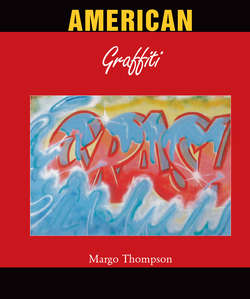Читать книгу American Graffiti - Margo Thompson - Страница 15
На сайте Литреса книга снята с продажи.
Subway Writers
QUIK and SEEN
ОглавлениеSome writers turned their hands to canvas and found their careers gained more traction in Europe than in the United States. This was true for BLADE, and also for QUIK and SEEN. QUIK was an extraordinarily prolific writer who began tagging trains as a young teenager in 1972. A few years later, he saw canvases by the Nation of Graffiti Artists – an organisation that splintered from United Graffiti Artists in 1974–near his high school, and he made his first graffiti painting on canvas soon afterwards. He felt that writing was an outlet for artistically-inclined African Americans who otherwise had few opportunities to express themselves: ‘Our society did not encourage us to be creative. We were social misfits. Thus this sector of the population decided to create its own art world and guidelines toward creativity: not necessarily in galleries, universities, cafes and shops, but on the hard steel flesh of the New York subway’.[74] His tags sometimes had a political edge: after a subway fare increase, he turned the Q into a face that grew fangs, calling the MTA blood-suckers. He was less interested than other writers in pleasing his audience, whether it was fellow writers or the public at large: ‘My style was aesthetically displeasing; people felt uneasy with it. My letters don’t look like letters, they look like monsters or eggs with holes’.[75] QUIK’s paintings from the 1980s, and those he paints today, also challenged the viewer. The taunting face of his tags was on canvas transformed into a full-length figure of a crucified black man, symbolising the tragedy of racism in the United States.
NOC 167, Gold Chain, 1981. Aerosol paint on canvas, 106 × 120 cm. Galerie Yaki Kornblit, Amsterdam.
LEE, Stop the Bomb, 1979. Aerosol paint on New York subway car. Destroyed.
SEEN, of the United Artists crew, was famous amongst his peers for his masterful renditions of mass-media cartoon characters like Fred Flintstone and the Smurfs. In the 1980 whole-car piece ‘Hand of Doom,’ a masked, muscular executioner holding a double-headed axe loomed ominously at the left of the green, lower-case lettering. A hand grasping a bloody blade emerged from the centre of the phrase. SEEN also mastered wild-style writing, as seen in a top-to-bottom whole car that he executed with MITCH in 1980. Both the colours and the composition were complex. Yellow blended smoothly into pink, which faded into blue, and the transition was uniform across letters that intertwined so ornately as to be illegible to non-writers. It looked at first as though SEEN had been lucky enough to find a clean subway car for his brilliant, busy design, because it was set against an almost uniform metallic grey background. But the windows were silvery too and the grey field had cracks running through it: SEEN and MITCH painted the entire car as a crumbling stone wall with their pieces bursting through triumphantly.
SEEN’s paintings often incorporated his tag, or the tags of others in his crew such as P-JAY or his brother MAD. He produced his first canvas in 1979, and in 1981 or 1982 he says Henry Chalfant encouraged him to go to Europe to continue working on canvas.[76] There he found a receptive audience, as did QUIK; their careers outside the United States will be discussed in Chapter Four.
74
Graffiti Art. Artistes américains et français, 71.
75
Museum Boijmans Van Beuningen, Graffiti (Rotterdam: Museum Boijmans Van Beuningen, 1983), 38.
76
Hoekstra, 266.
